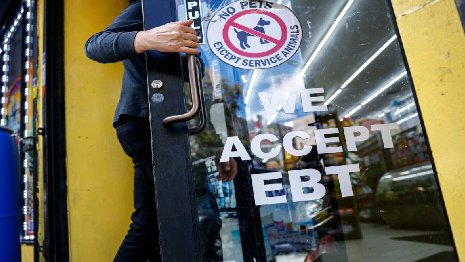America could experience surge in credit card debt as SNAP benefits end for millions of people
The ongoing federal government shutdown, now in its 34th day since October 1, has halted November Supplemental Nutrition Assistance Program (SNAP) benefits for over 42 million Americans, forcing many low-income families to turn to credit cards and high-interest loans to buy food, experts warn.
A federal judge’s October 3, order blocked the Trump administration from fully cutting off payments, requiring use of a $5.25 billion emergency fund, but it falls short of the $9 billion needed for the month, per USDA data.
The disruption, affecting 1 in 8 Americans, could trigger a debt spike as average credit card APRs exceed 20%, with households already on poverty’s edge facing long-term financial ruin, according to financial experts and SNAP advocates.
Shutdown’s Impact on SNAP and Household Finances
SNAP, formerly food stamps, provides an average $291 monthly per household via EBT cards for groceries, serving 42.1 million people in fiscal 2025, including 20 million children, per USDA’s September 2025 report.
The shutdown halted reloads starting November 1, with states like California and New York issuing partial October payments from reserves, but November remains uncovered federally, per Newsweek. Some states, including Texas and Florida, activated emergency funds for limited extensions, but most rely on food banks overwhelmed by demand.
Kevin Thompson, CEO of 9i Capital Group said, “When EBT cards aren’t reloaded on time, people often turn to what little credit they have left, whether that’s maxing out a credit card, taking a quick cash loan with astronomical rates, or simply going without essentials altogether.”
Cynthia Chen, CEO of Kikoff, added, “As balances grow, so does the risk of missed payments, lower credit scores, and shrinking access to affordable credit options.”
Alex Beene, University of Tennessee at Martin instructor, noted, “Often forgotten in the discussion over the gap in funding SNAP is the domino effect it can have on recipients… This creates an even bigger financial hole for that individual and their family to climb out of once the shutdown ends.”
Ofek Lavian, CEO of Forage, said, “Delays in food assistance will push low-income families toward credit card debt and other predatory options, as they face the impossible choice between feeding their families in November or suffering long-term financial consequences.” Thompson described “modern bread lines” at food banks.
The judge’s order, by U.S. District Judge John Bates in D.C., mandates tapping the Contingency Reserve Fund, but $5.25 billion covers only 58% of November needs, per USDA estimates. The shutdown, over disputes on Obamacare subsidies and $1 trillion rescissions, has furloughed 800,000 workers.
Leaders Playing Politics
Trump blamed Democrats on Truth Social November 1, “They want illegal aliens to get massive health care at the cost to everybody else,” claiming they aim “to destroy” military celebrations. Democrats like Senate Minority Leader Chuck Schumer called it “cruel.”
States like Illinois (Pritzker) and California (Newsom) pledged emergency aid, but coverage varies; New York activated $500 million reserves, per NYT. Food banks report 40% demand spike.
TOP STORIES
- Jack Smith reveals he had ‘tons of evidence’ against Trump
- ICE detains MAGA voter’s wife who supported Trump’s mass deportation plan
- ICE Detains Wife of Staunch MAGA Supporter Who Donated Almost All His Net Income to Trump Campaign
As the shutdown drags, negotiations stall; Trump threatens mass layoffs at “Democrat agencies.” Partial SNAP restoration may occur by November 15 if a CR passes, but full funding requires a budget deal. Experts predict $2-3 billion in new debt from credit reliance.
Discover more from STITCH SNITCHES
Subscribe to get the latest posts sent to your email.
